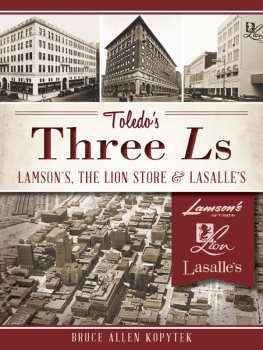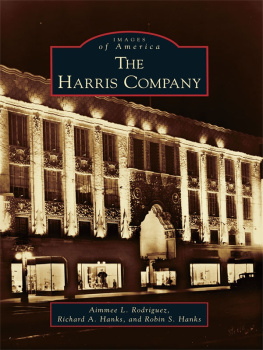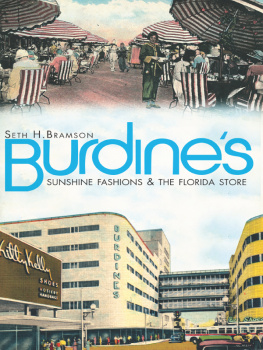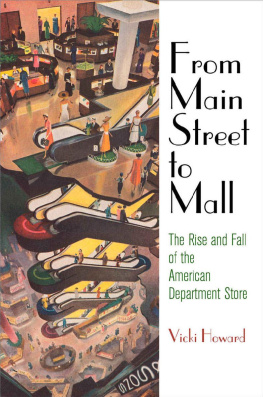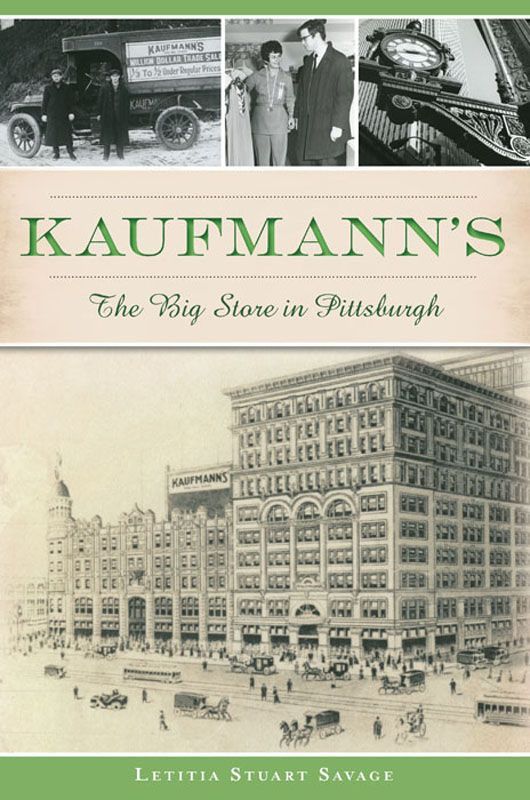

Published by The History Press
Charleston, SC
www.historypress.net
Copyright 2016 by Letitia Savage
All rights reserved
All images courtesy of Detre Library and Archives Division, Heinz History Center,
Pittsburgh, Pennsylvania.
First published 2016
e-book edition 2016
ISBN 978.1.62585.776.7
Library of Congress Control Number: 2016944006
print edition ISBN 978.1.46711.990.0
Notice: The information in this book is true and complete to the best of our knowledge. It is offered without guarantee on the part of the author or The History Press. The author and The History Press disclaim all liability in connection with the use of this book.
All rights reserved. No part of this book may be reproduced or transmitted in any form whatsoever without prior written permission from the publisher except in the case of brief quotations embodied in critical articles and reviews.
For my mother, who introduced us to Kaufmanns shopping and lunch at the Tic Toc.
CONTENTS
ACKNOWLEDGEMENTS
Archivists and volunteers at the Senator John Heinz History Center for help identifying and accessing the Kaufmanns Department Store manuscripts and photographs: thank you for scanning to meet our deadlines and for working out of borrowed space on an April Saturday rather than closing the archives during a history center conference.
Those Kaufmannites who donated materials now in the Heinz History Center archives.
The Pittsburgh Post-Gazette for scanning its extensive newspaper archives and making them available online. This archive provided more than one hundred years of advertisements and news articles on Kaufmanns, including material that wasnt available elsewhere. For those who would like to shop the stores of the past, this archive can provide hours of entertainment.
Northland Public Library, whose librarians and volunteers provided interlibrary loan services.
All of the people who shared their memories of the store over the years with the press and online. Each memory is a piece of history.
My husband and research associate, William Ebner, who persisted with Kaufmanns material when he would rather have been reading Fort Pitts 1763 daybook.
Introduction
MEET ME UNDER THE CLOCK
When Macys decided to close its Downtown Pittsburgh store in September 2015, the public responded with a flood of shared memories. While the historic Kaufmanns building would remain, it would no longer house a department store. There would be no more thumbprint cookies from the Arcade Bakery and no more lunches at the Tic Toc Restaurant. But the iconic clock would survive.
As Pittsburghers mourned the final demise of the store, they celebrated the clock. For almost a century, meeting under the clock had been a city tradition. For more than a century, the clock was a symbol of Kaufmanns.
The first Kaufmanns clock with four faces stood on a pedestal on the corner in front of the store. A sign on the pedestal encouraged, Meet Me Under the Clock. Built in 1884, it was removed when the store was expanded in 1912. There was an immediate public outcry. Henry Kaufmann ordered an ornate brass clock from the Coldwell Clock Company in New York and had it installed on the building in 1913.
By World War II, the clock had become the recognized symbol of the store, and its role as a meeting place was celebrated in Yank magazine. In December 1981, it and the Kaufmanns building were granted landmark status by the Pittsburgh History and Landmarks Foundation.
Six years later, the clock disappeared again, and the public noticed. But the clock was gone for all the right reasons. Kaufmanns, as part of a major renovation, had sent it for restoration. It took three days to carefully remove and label one hundred pieces of the ornate metalwork. Three teams of fifteen local specialists worked for ten weeks to clean, polish and restore the 2,500-pound brass clock. They made new molds for missing and damaged parts and cast replacements. They installed a new, dual-drive movement. The restored clock was unveiled on Light Up Night in November 1987, just in time for holiday meetups.

The original Kaufmanns clock was four-faced and stood on a pedestal at the corner of Fifth Avenue and Smithfield Street. When it was removed during the stores 1912 expansion, there was such public outcry that Henry Kaufmann ordered a new clock, which was installed on the store building.

In 1981, Kaufmanns building and iconic clock received landmark status from the Pittsburgh History and Landmarks Foundation. The plaque remained on the building after Kaufmanns became a Macys store in 2005.

The clock was removed and restored during the spring and summer of 1987. Local specialists recast missing and damaged pieces and sandblasted and polished the ornate figures.
Although the beloved store is gone, the new owner of the Kaufmanns building, CORE Realty, has committed to retaining the clock as it converts the building to mixed commercial/residential use. But the iconic store was always more than the clock out front.
Chapter 1
A NEW COMMERCIAL BABY
When Jacob Kaufmann immigrated to the United States in 1868 from Viernheim, Germany, he didnt find work in the sweatshops of New York, like so many other immigrant tailors did. Instead, he headed for western Pennsylvania, where he invested his limited funds in merchandise and became an itinerant peddler. Carrying his goods on his back, he traveled on foot through the rural counties outside Pittsburgh. He saved his profits and was soon able to ask his brother Isaac to join him. His goal was to set up a tailor shop.
On May 25, 1871, a local newspaper on Pittsburghs South Side carried a small advertisement announcing the birth of a commercial baby at 1916 Carson Street. Jacob and Isaac had opened a small clothing shop called J. Kaufmann and Brother. The South Side had no clothing store, and the construction of a large Jones and Laughlin steel mill nearby was bringing working men to the neighborhood. In addition to tailoring, the brothers carried a small stock of mens ready-to-wear clothing. The store offered suits cut from the latest Philadelphia and New York patterns, which required considerable skill. The tiny space, 476 square feet, was dominated by a large cutting table and crowded with bolts of fabric. The brothers also added a couch where they slept after working late into the night. The next year, they moved into a bigger space at 1932 Carson Street.
Isaac and Jacob had inherited considerable business sense from their father, Abraham Kaufmann, who was a successful cattle dealer. He advised them, Sell to others as you would buy for yourself. His advice became the guiding principles of the business: Good merchants make small profits and many salesDeal fairly and be patient and in time dishonest competitors will crowd your store with customers.


